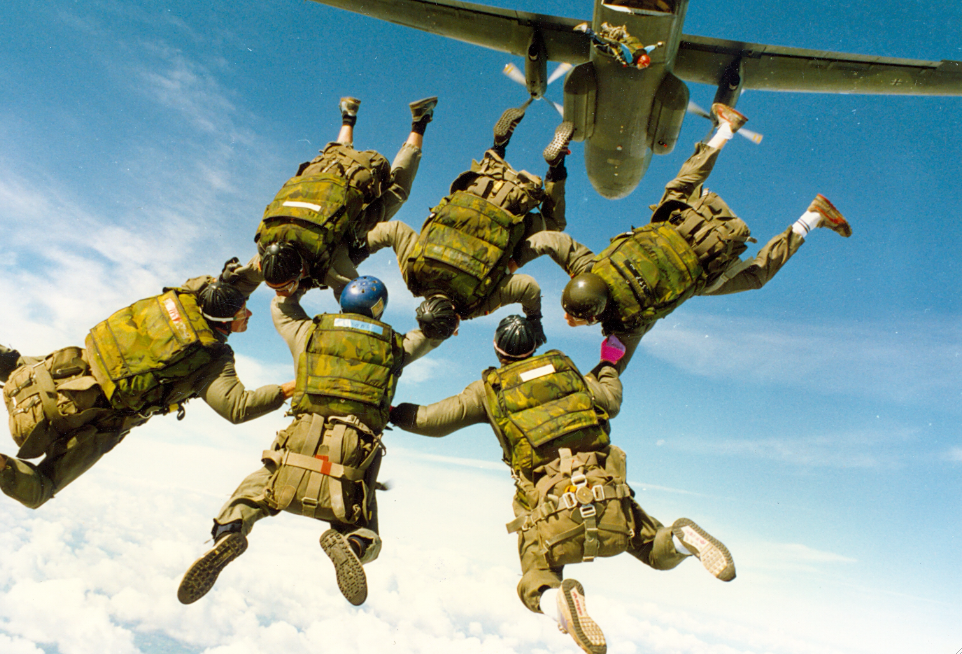
Die 1990er Jahre
On 2 August 1990 some 100,000 Iraqi soldiers crossed into Kuwait. Within a few hours of this invasion the UN Security Council passed Resolution 660, condemning the invasion and demanding the withdrawal of the Iraqi forces. On 16 January 1991, one day after the ultimatum associated with UN Resolution 678 expired, the anti-Saddam coalition initiated massive airstrikes . On the evening of 17 January the land operations phase of Operation Desert Storm began.
The German contribution to this effort consisted of naval forces, including mine-warfare vessels which were deployed to reinforce NATO’s southern flank in the Mediterranean in what is considered the postwar German armed forces’ first out-of-area mission. On 6 March 1991, after combat operations had ceased in Iraq and Kuwait, the mine-warfare forces were relocated to the Persian Gulf to participate in mine clearing off the Kuwaiti coast. Members of the Kampfschwimmer Company were on board the German minesweepers. Their mission: secure the minesweeper detachment as well as high-profile individuals against terrorist attacks of any kind or magnitude.
While most of the company was tied up in this operation, a reorganization of the German Navy was taking place back home. This organizational reform, designed to reorient the armed forces for the post Cold War world, had significant (and challenging) consequences for the Kampfschwimmer, who lost their status as an “independent unit”. The Seebataillon was disestablished on 2 October 1991. In its stead the Waffentauchergruppe (“Armed Diver Group”) was established in Eckernförde as a subordinate unit of the Mine Warfare Forces Flotilla (Flottille der Minenstreitkräfte). It was composed of a headquarters platoon, the significantly downsized Kampfschwimmer Company, the Minentaucher Company (Mine Clearance Diver Company), a newly formed training company, and the minesweepers Mühlhausen and Langeoog. The training company was made up of the Kampfschwimmer training platoon, the underwater mine clearance training platoon and an EOD/IEDD platoon (Explosive Ordnance Disposal/Improvised Explosive Device Disposal).
In 1994 the naval commandos were finally able to fully utilize their expertise in boarding operations. These capabilities had been the subject of much controversy within the fleet, and had received very little official support up to this point. Fighting within the territory of the former Yugoslavia, prompted by the secession of Slovenia and Croatia, prompted NATO to establish the maritime surveillance mission OPERATION SHARP GUARD in the Adriatic. The Kampfschwimmer provided the German contribution to the Maritime Interdiction Force which was tasked with checking out so called Contacts of Interest (i.e. suspicious vessels).
In 1994, the Kampfschwimmer conducted their first ever boarding operations as part of the NATO-led maritime surveillance mission Operation Sharp Guard in the Adriatic Sea. Boarding skills – a prerequisite for effective embargo enforcement – were suddenly in high demand. While German naval vessels were quite capable of stopping ships, the fleet did not have organic boarding teams made up of armed specialists trained in fast rope, repelling, or hull climbing techniques. These capabilities – a prerequisite for boarding uncooperative vessels – had only been acquired and honed by the Kampfschwimmer. Their decision to perfect these skills (against considerable opposition from within the naval establishment) during the 1980s now proved prescient.
Limited berthing on the deployed frigates and destroyers precluded despatching complete Kampfschwimmer teams. When the frigates and destroyers were originally configured, boarding operations were not included in operational doctrine, and so no provisions were made for accommodating additional personnel beyond the regular crew. As a result the Kampfschwimmer ended up training members of the core crew – mostly navigation, bridge and engineering personnel – to serve as auxiliary members of the boarding team. These auxiliaries boarded the target vessel as a “second wave” following the commandos; they were employed as guards and took control of the bridge and engine room. A truly revolutionary step was employing reserve officers as Embargo Control Liasion Officers (ECLO). The ECLOs were usually former merchant mariners familiar with documentation carried aboard commercial vessels. This knowledge made them a great support asset for the boarding teams. The naval commandos had originally proposed introducing the ECLOs, and the idea had been quickly adopted.
During the mid-1990s the naval commandos trained the personnel of the German Navy’s Maritime Security Forces (Marinesicherungstruppen) in boarding procedures; the latter personnel would later assume full responsibility for boarding operations. In 2003 the Naval Special Operations Forces (Spezialeinsatzkräfte der Marine – SEK M) established a dedicated boarding company. (For details see Norman Bronch, “Ausbildung der Boardingssicherungssoldaten”, in Marine Forum, 5/2012)
Meanwhile, German army forces had been providing security assistance in Somalia since July 1993. In Decemner 1993 the German government decided to withdraw these troops by the end of March 1994. Withdrawal by air was ruled out because of the remaining threat level. This meant that the German navy had to evacuate the withdrawing forces by sea. And again it became evident that the navy lacked fleet security forces to protect ships in hostile environments. So the Kampfschwimmer were tasked, since they enjoyed organic tactical mobility (speedboats) and highly-trained snipers and counter-snipers. Their mission: protect the squadron and individual VIPs from terrorist attacks. The German army contingent boarded transport ships in the port of Mogadishu. The deployed Kampfschwimmer commandos were the last German military personnel to leave Somalia. Between operations in the Adriatic and East Africa, every member of the Kampfschwimmer Company was operationally deployed during 1994.
Meanwhile in 1994, Belgian paratroops had to evacuate German citizens from Rwanda, which was caught up in a genocidal civil war. On 14 March 1997 German armed forces evacuated 104 people (Germans as well as other nationals) from the German embassy in the Albanian capital Tirana. Both operations demonstrated that Germany suffered a capabilities gap with regard to rescue and evacuation missions. Establishment of the German army’s own own special operations unit, the brigade-sized Kommando Spezialkräfte (Special Operations Forces Command) or KSK, was, at least in part, an inescapable response to the fundamental changes in the changing mission spectrum facing the Bundeswehr in the mid-1990s. The German armed forces were facing a turning point. The had to evolve from a territorial defense force to an international expeditionary force. Especially during the early 1990s the Kampfschwimmer Company faced great challenges, being attached to other contingents and enduring long deployments. The unit’s small size and occasional use as a “911 force” exacerbated the difficulties. Insufficient knowledge about SOF operations and tactics (on the part of the conventional forces and/or commanders), inadequate equipment and transportation assets, and unfavorable operating environments came together to push the commandos to their very limits. The transformation of the armed forces into an expeditionary force – and the learning curve associated with that transformation – had serious consequences for the Kampfschwimmer Company.
Focused on the so called “Peace Dividend” following the end of the Cold War, the German armed forces lost interest in the Kampfschwimmer as an offensive tool of naval warfare. Suggestions to integrate the Kampfschwimmer of the former East German armed forces (which had developed excellent special boat units for commando transport) into the Kampfschwimmer Company, or combine both units into an evacuation squadron were immediately quashed.
The “Peace Dividend’s” resulted in a significant reduction in armed forces personnel strength; this impacted the Kampfschwimmer Company too. The number of enlisted personnel who were allowed to extend their commitments and become career sailors was curtailed. The Kampfschwimer lost more than fifty percent of their operational personnel. The damage to their force structure was so severe that it is still felt today, especially among the senior NCO ranks. Changes in organization, manpower and equipment, as well as a lack of support infrastructure, had reduced the once unique capabilities of the unit to a bare minimum.
The German armed forces as a whole underwent a transformational process in the 1990s. This transformation is reflected in the Kampfschwwimmer mission statement, which was amended to:
Operations against enemy port and coastal installations and vessels;
Reconnaissance of enemy ports, coastal installations, beaches and roadsteads;
Locating, identifying, and marking or demolition of underwater obstacles;
Participation in seaward security for ports and vessels;
Participation in EOD/EOR missions;
Beach and surf-zone reconnaissance and surveying.
Following dissolution of the Maritime Battalion in October 1991 the Kampfschwimmer Company remains the German armed forces only combat unit with expertise in amphibious operations. To satisfy the new, defensively oriented, mission spectrum the Kampfschwimmer unit increased its training for seaborne Combat Search and Rescue missions in support of NATO or UN operations. The SFOR mission underway at the time highlighted the need for such capabilities. German Tornado aircraft were conducting surveillance flights over the territory of the former Yugoslavia. Had there been a crash, the Kampfschwimmer would have been able to provide assistance. Their capabilities, in conjunction with the navy’s vessels and aircraft, made the navy he only German service branch capable of autonomously conducting such operations.
The unit’s EOD capabilities were also honed during this period. The company frequently detached individual explosive ordinance specialists for duty in the Balkans. With their specialized equipment and their personnel, the Kampfschwimmer quickly became a vital asset, operating independently or augmenting other units, wrote Thorsten Mathesius in his article “Die Kampfschwimmer – Zeitgerechte Antwort auf neue Herausforderungen” (“The Kampfschwimmer – A Timely Response to new Challenges”) in Marine Forum 11-1992.
























